Data encryption standards such as AES, RSA, and TLS play a crucial role in safeguarding sensitive information, particularly in cloud environments like SaaS in the UK. AES employs a symmetric key algorithm to encrypt data in fixed-size blocks, while RSA utilizes public key cryptography for secure data transmission. Together, these standards ensure compliance and enhance data security across various applications.

What are the best data encryption standards for SaaS in the UK?
The best data encryption standards for SaaS in the UK include AES, RSA, and TLS. These standards ensure data security by providing robust encryption methods suitable for protecting sensitive information in cloud environments.
AES (Advanced Encryption Standard)
AES is a symmetric encryption standard widely used for securing data. It operates on fixed block sizes and supports key lengths of 128, 192, and 256 bits, making it highly efficient and secure for various applications.
In practice, AES is often used to encrypt data at rest and in transit, ensuring that unauthorized users cannot access sensitive information. Many compliance frameworks in the UK, such as GDPR, recommend or require the use of AES for data protection.
RSA (Rivest-Shamir-Adleman)
RSA is an asymmetric encryption algorithm that uses a pair of keys: a public key for encryption and a private key for decryption. This method is particularly useful for secure data transmission over the internet.
RSA is commonly employed in scenarios like secure email and digital signatures. While it offers strong security, it is slower than symmetric encryption methods like AES, making it less suitable for encrypting large amounts of data directly.
TLS (Transport Layer Security)
TLS is a cryptographic protocol designed to provide secure communication over a computer network. It ensures data integrity, confidentiality, and authentication between clients and servers.
In the UK, TLS is essential for securing web applications and services, particularly in SaaS environments. It is commonly used to protect sensitive transactions, such as online banking and e-commerce, by encrypting data in transit.
Comparison of AES, RSA, and TLS
AES, RSA, and TLS serve different purposes in data encryption. AES is best for encrypting large volumes of data efficiently, while RSA is ideal for secure key exchange and small data sets. TLS, on the other hand, secures communication channels.
| Standard | Type | Use Case | Key Length |
|---|---|---|---|
| AES | Symmetric | Data at rest/in transit | 128, 192, 256 bits |
| RSA | Asymmetric | Secure key exchange | Typically 2048 bits or more |
| TLS | Protocol | Secure communication | N/A |
Choosing the right encryption standard depends on your specific needs, such as the type of data, the required speed, and the regulatory environment. Combining these standards can enhance overall security in SaaS applications.
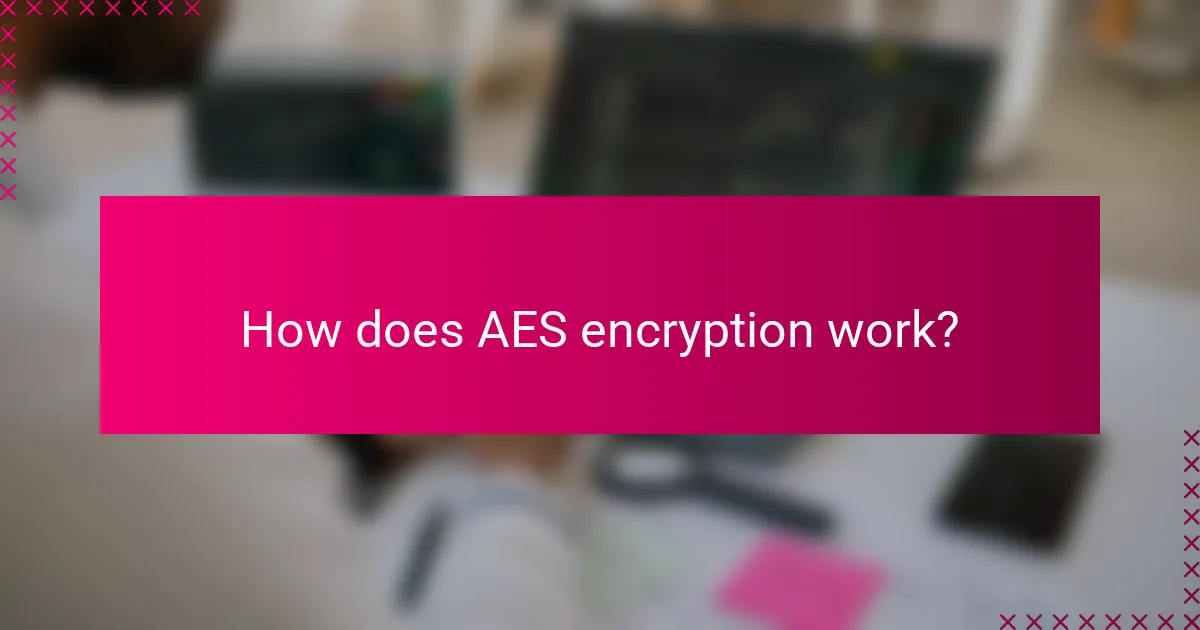
How does AES encryption work?
AES encryption works by transforming data into a secure format using a symmetric key algorithm. It encrypts data in fixed-size blocks, making it a widely adopted standard for securing sensitive information across various applications.
Block cipher mechanism
The AES algorithm operates as a block cipher, processing data in 128-bit blocks. It employs a series of transformations, including substitution, permutation, and mixing, to obscure the original data. Each transformation is repeated multiple times, known as rounds, which can vary based on the key size used.
For AES, the number of rounds is determined by the key length: 10 rounds for 128-bit keys, 12 for 192-bit keys, and 14 for 256-bit keys. This structure enhances security by making it difficult for unauthorized users to reverse-engineer the encrypted data.
Key sizes and security levels
AES supports key sizes of 128, 192, and 256 bits, with each size providing different levels of security. Generally, a longer key length offers greater resistance against brute-force attacks, making 256-bit keys the most secure option available. However, 128-bit keys are often sufficient for many applications, balancing security and performance.
When choosing a key size, consider the sensitivity of the data and the potential threats. For highly sensitive information, opting for 256-bit keys is advisable, while 128-bit keys can be adequate for less critical data. Regularly updating keys and employing best practices in key management are essential for maintaining data security over time.
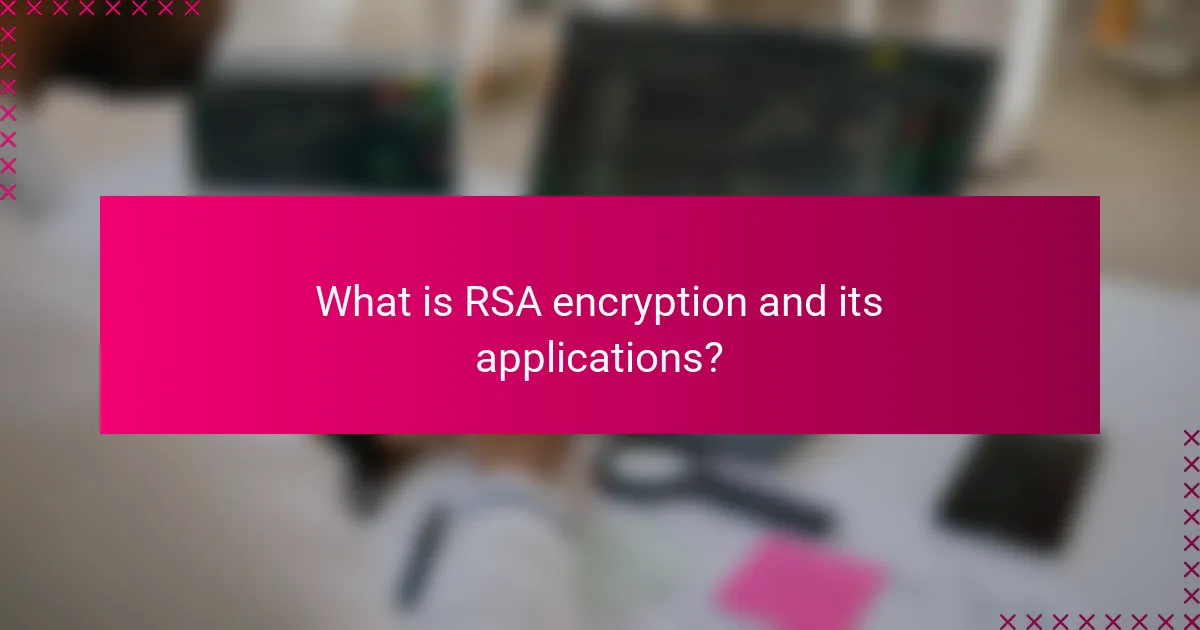
What is RSA encryption and its applications?
RSA encryption is a widely used public key cryptography method that enables secure data transmission. It relies on the mathematical properties of large prime numbers to encrypt and decrypt messages, making it essential for secure communications across various applications.
Public key cryptography
Public key cryptography, like RSA, uses a pair of keys: a public key for encryption and a private key for decryption. This system allows users to share their public key openly while keeping their private key secret, ensuring that only the intended recipient can decrypt the message. The security of RSA is based on the difficulty of factoring large numbers, which makes it computationally challenging for unauthorized parties to access the private key.
Use cases in secure communications
RSA encryption is commonly employed in securing sensitive data during online transactions, email communications, and digital signatures. For instance, when you make a purchase on an e-commerce site, RSA can be used to encrypt your payment information, ensuring that it remains confidential. Additionally, it plays a crucial role in establishing secure connections over the internet, such as in SSL/TLS protocols.
Organizations often implement RSA in conjunction with other security measures, like symmetric encryption, to enhance overall data protection. It’s important to choose key sizes of at least 2048 bits for robust security, as smaller keys may be vulnerable to modern computational attacks.
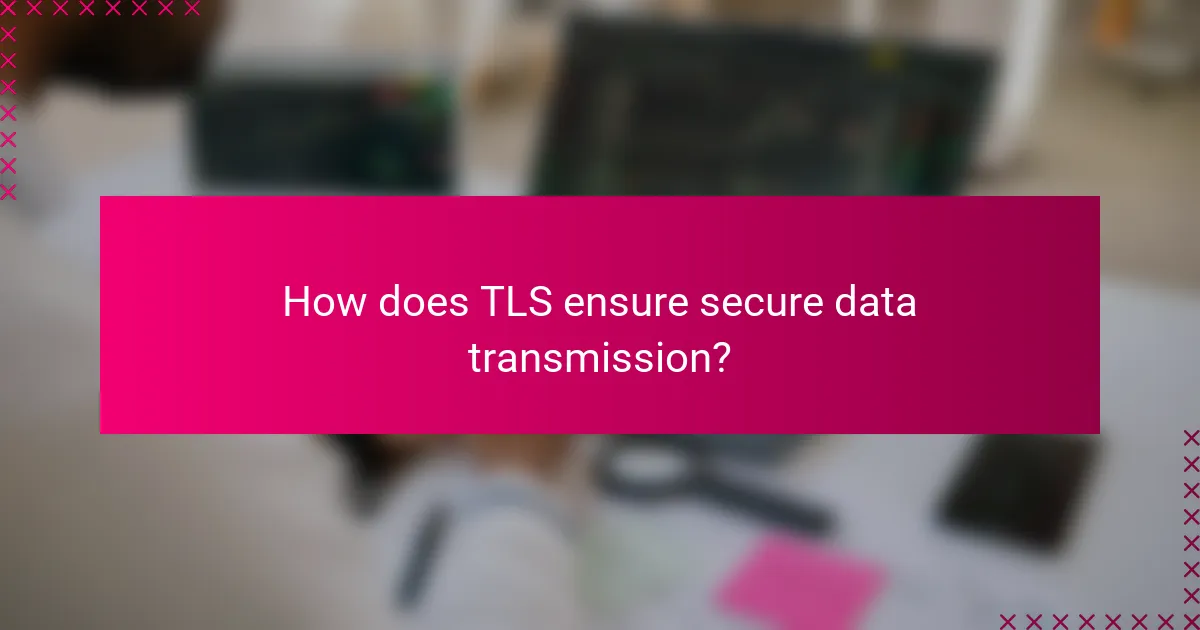
How does TLS ensure secure data transmission?
TLS (Transport Layer Security) ensures secure data transmission by encrypting the data exchanged between clients and servers, thereby protecting it from eavesdropping and tampering. It establishes a secure connection through a series of steps that authenticate the parties involved and negotiate encryption methods.
Handshake process
The TLS handshake is the initial step in establishing a secure connection. During this process, the client and server exchange messages to agree on encryption algorithms, authenticate each other, and establish session keys. This typically involves the client sending a “ClientHello” message, followed by the server’s “ServerHello” response, which includes its digital certificate for authentication.
Both parties then negotiate the cryptographic parameters, including the cipher suite, which determines the encryption methods used. The handshake concludes with the exchange of session keys, allowing for secure communication to begin.
Session keys and encryption
Session keys are temporary encryption keys generated during the TLS handshake, used to encrypt the data transmitted during that session. These keys ensure that even if a session is compromised, the data remains secure as the keys are unique to each session and discarded afterward.
TLS typically employs symmetric encryption for data transmission, which is efficient and fast. Common algorithms include AES (Advanced Encryption Standard) and ChaCha20. The use of session keys and strong encryption methods helps maintain confidentiality and integrity of the data exchanged between parties.
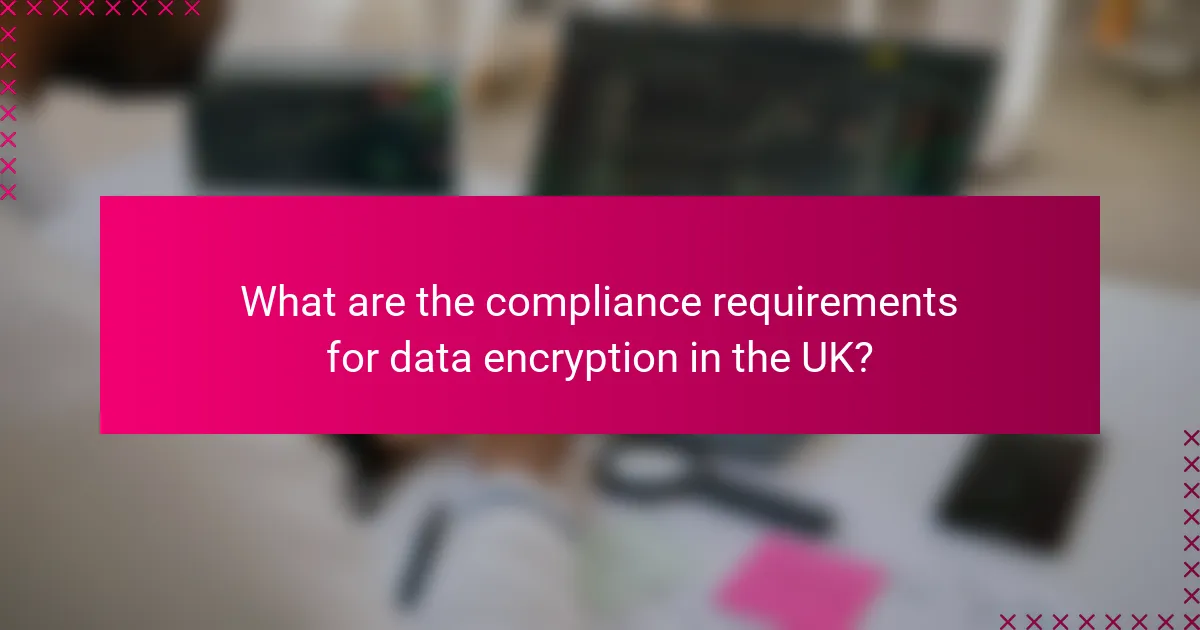
What are the compliance requirements for data encryption in the UK?
In the UK, compliance requirements for data encryption are primarily governed by regulations like GDPR and the Data Protection Act 2018. Organizations must ensure that personal data is encrypted to protect it from unauthorized access and breaches.
GDPR regulations
The General Data Protection Regulation (GDPR) mandates that organizations implement appropriate technical measures, including encryption, to safeguard personal data. This regulation emphasizes the importance of data security and requires that encryption be used as a means to protect sensitive information.
Under GDPR, if personal data is encrypted and a breach occurs, the risk to individuals is significantly reduced, potentially alleviating the need for notification. Organizations should assess their data processing activities and determine where encryption can be applied effectively.
Data Protection Act 2018
The Data Protection Act 2018 complements GDPR by outlining specific requirements for data protection in the UK. It reinforces the necessity for encryption as a security measure and mandates that organizations take steps to ensure the confidentiality and integrity of personal data.
Organizations must conduct regular assessments of their encryption practices and update them as necessary. Failure to comply with these requirements can lead to significant fines and reputational damage, making it essential to prioritize encryption in data protection strategies.

What factors should be considered when choosing an encryption standard?
When selecting an encryption standard, consider performance, scalability, regulatory compliance, and the specific use case. Each factor plays a crucial role in ensuring that the encryption meets both security requirements and operational efficiency.
Performance and speed
Performance and speed are critical when choosing an encryption standard, especially for applications requiring real-time data processing. For example, symmetric encryption methods like AES are generally faster than asymmetric methods like RSA, making them suitable for high-volume transactions.
When assessing performance, consider the encryption and decryption times, which can vary significantly. Low tens of milliseconds for AES might be acceptable for most applications, while RSA could take several seconds, impacting user experience.
Scalability for SaaS applications
Scalability is essential for Software as a Service (SaaS) applications, which often handle varying loads and user numbers. An encryption standard should efficiently support growth without sacrificing performance or security. For instance, AES can easily scale to accommodate increased data loads, while RSA may require more resources as user numbers grow.
Consider how the encryption standard integrates with cloud services and whether it supports multi-tenant architectures. A flexible encryption solution can adapt to changing demands, ensuring that security measures remain robust as the application evolves.
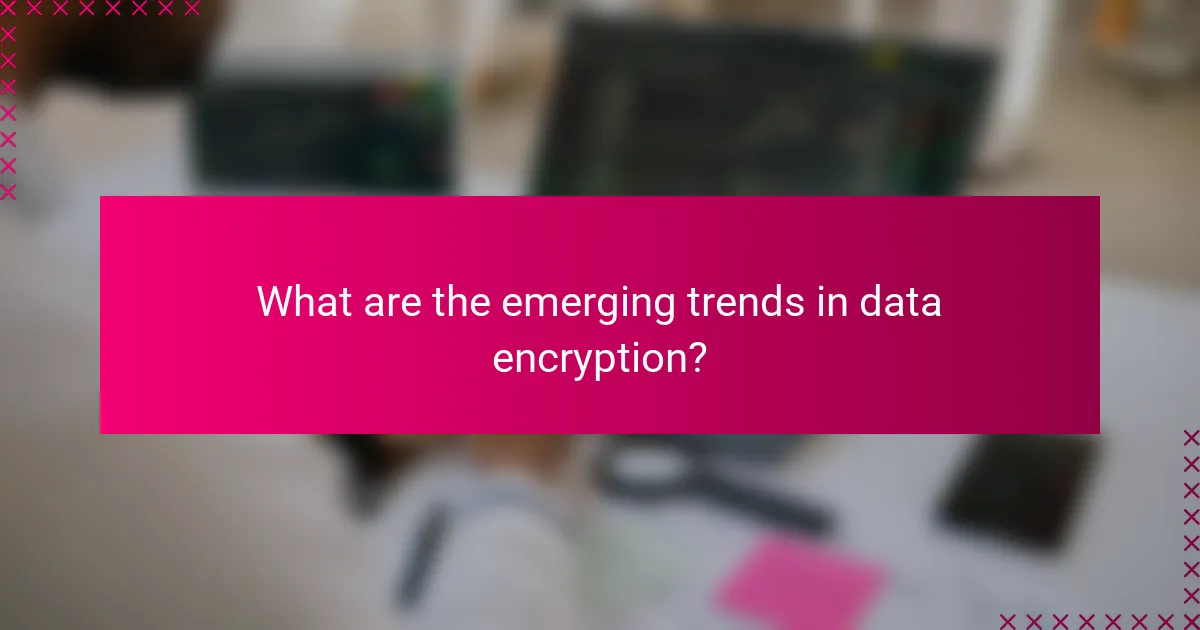
What are the emerging trends in data encryption?
Emerging trends in data encryption focus on enhancing security through innovative technologies and methodologies. Key developments include quantum encryption and AI-driven solutions, which aim to address vulnerabilities in traditional encryption methods.
Quantum encryption technologies
Quantum encryption technologies leverage the principles of quantum mechanics to secure data transmission. This approach, particularly Quantum Key Distribution (QKD), ensures that any attempt to intercept the data will be detectable, providing a higher level of security compared to classical methods.
Organizations considering quantum encryption should evaluate their specific needs and the current state of quantum infrastructure. While still in the early stages, quantum encryption is expected to become more accessible, with potential applications in sectors like finance and healthcare where data sensitivity is paramount.
AI-driven encryption solutions
AI-driven encryption solutions utilize machine learning algorithms to enhance data protection by adapting to emerging threats in real-time. These systems can analyze patterns and anomalies in data access, allowing for dynamic encryption strategies that respond to potential breaches.
When implementing AI-driven encryption, organizations should ensure they have robust data governance policies in place. This includes regular audits and updates to the AI models to maintain effectiveness against evolving cyber threats. Additionally, training staff on these technologies can help mitigate risks associated with human error.
